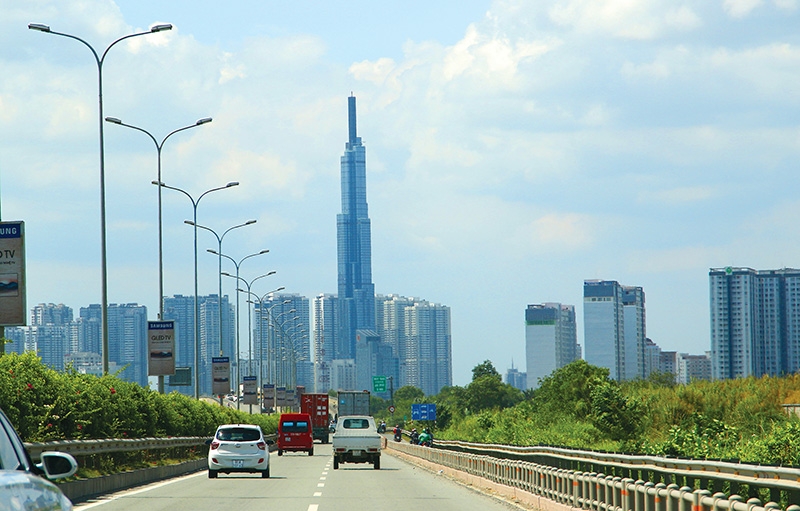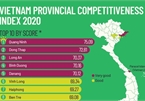 |
| While some provinces have become shining examples in Vietnam’s PCI, its metropolises are lagging behind. Photo: Le Toan |
According to the Korea Chamber of Business in Vietnam (KorCham), Hanoi is planning to organise a dialogue with South Korean businesses in May to help them deal with various problems, including administrative procedures.
KorCham vice chairman Hong Sun told VIR, “South Korean businesses are still encountering some problems related to investment procedures, especially real estate and trade centre investments and others. We are expecting that all will be solved at the upcoming meeting.”
South Korea is among the targeted foreign investors Hanoi plans to attract more of. To increase its attraction, the city has taken a number of measures to reform administrative procedures. According to Hanoi People’s Committee, the capital had been determined to deploy the government’s administrative reform plan for the 2016-2020 period, and the city’s administrative reform programmes in which many targets were fulfilled before the schedule set in Resolution No.30c/NQ-CP on the master programme on administrative reform in the 2011-2020 period.
Nonetheless, Hanoi’s stronger efforts have not brought about a fruitful result. Most recently, in the 2020 Provincial Competitiveness Index (PCI), the city ranked ninth, with no increase from the previous year.
As shown in the 2020 PCI, the results of the 10 sub-indices making up the city’s overall PCI index remain lower than cities and provinces in the “excellent” category and, in terms of entry costs and land access, Hanoi is named among the lowest.
Specifically, entry costs score 6.74 out of 10; land access and tenure scores 6.07; policy bias and proactivity both 6.06; and transparency even 5.81. In comparison, the three best performers of Long An, Dong Thap, and Quang Ninh have scored over seven points in most of their 10 sub-indices.
In the same situation, as shown in the 2019 and 2020 PCI indexes, Ho Chi Minh City dropped from eighth in 2016 to 14th now. In the Vietnam Provincial Governance and Public Administration Performance Index (PAPI), the biggest city of Vietnam also saw a downgrade from 31st in 2019 to 46th in 2020, ranking among the worst performers.
The northern province of Bac Ninh also saw a slip from fourth in the 2019 PCI to 10th in 2020. Vuong Quoc Tuan, Deputy Chairman of Bac Ninh People’s Committee, blamed this for a decrease of score in the areas of transparency, policy bias, law and order, proactivity, land access, and tenure. “We will take bolder and more comprehensive measures to improve them in the months to come,” he insisted.
A few days after the announcement of the 2020 PCI, Nguyen Thanh Phong, Chairman of Ho Chi Minh City People’s Committee, worked with the city’s Institute for Development Studies on the implementation of the 2021 tasks. “Recently, local authorities reported that they all made better achievements. Why this has happened is unclear,” he admitted. “They have to reassess themselves. If we do not assess ourselves exactly, we are likely to get into the way of subjective thinking.”
Hanoi and Ho Chi Minh City have other connected issues on their collective plates because, according to statistics from the Ministry of Planning and Investment (MPI), the two cities also dropped in ranking in foreign direct investment (FDI) attraction in the first quarter of 2021. Ho Chi Minh City dropped from top of the pile in 2020 to fourth so far this year, while Hanoi fell to 14th from third in 2020.
Chairman Phong emphasised that the focus of Ho Chi Minh City this year is to improve the business climate and to build urban governance, urging stronger effort from local authorities to improve the situation.
Similarly, Chairman of Hanoi People’s Committee Chu Ngoc Anh, at a recent meeting to review the first-quarter performance and set tasks for the upcoming months, requested more administrative reforms to further facilitate business activities in the capital.
The major cities are being urged to learn from Quang Ninh, Long An, Dong Thap, and Binh Duong on how to make improvements to increase future efficiency in order to meet business expectations. Sun of KorCham noted, “The transition of the Hanoi leadership might bring about positive results, and South Korean investors are pinning high hopes on this.”
Outside Ho Chi Minh City and the capital, Long An and Binh Duong were among the most impressive localities in terms of the PCI results last year. The Mekong Delta province of Long An surpassed many others to be listed among the best performers, ranking third and rising from eighth in the 2019 index. Binh Duong meanwhile jumped to fourth from 13th the previous year.
Long An is emerging as an attractive destination for foreign investment. In the first quarter, the province led 63 cities and provinces in FDI inflows with nearly $3.2 billion, making up about 32 per cent of the country’s total. Meanwhile, Binh Duong remains in the top-six of FDI attractors.
Elsewhere, last week Long An signed MoUs with powerful domestic and international groups – Saigontel, Roland Berger, Viettel IDC, VNPay, Microsoft, Siemens, SAP, SMBL, and DVL Venture – on digital transformation and investment at its investment promotional workshop.
Nguyen Van Duoc, Secretary of Long An Party Committee, said, “We continue to make administrative reforms with a focus on the 10 sub-indices, thus further improving the business climate. We envision developing high-tech economic zones in parallel with the development of South Korean-modelled smart cities.”
|
John Rockhold - Vice chairman, American Chamber of Commerce Hanoi
Vietnam was successful in its dual efforts to contain the pandemic and maintain economic growth, emerging as one of the few countries in the world to record a reasonably high rate of positive economic growth in 2020. The Provincial Competitiveness Index’ (PCI) infrastructure index ranks the quality of infrastructure and connectivity in each province. This index is not included in the calculation of the PCI scores. However, it serves as a useful reference for businesses as well as policymakers. The PCI research team has determined it is unfair to include infrastructure in the overall ranking for three reasons: initial endowments were dramatically different across provinces, making it very difficult for some rural provinces to catch up; provinces are not solely responsible for infrastructure within their borders, as many investments are funded through central government initiatives; and the team strongly believes the improvement of infrastructure is best achieved through regional cooperation and does not want to encourage duplicative and damaging competition in construction, particularly for large projects such as ports and airports. Infrastructure in Vietnam has generally improved since 2014. However, in 2020, the median score of the infrastructure index dropped slightly to 67.41 points from the all-time high of 68.45 points, achieved in 2019. The findings show the correlation between the quality of governance and infrastructure in 2020. There remains a close correlation across all provinces. Consistent with previous surveys, the PCI 2020 finds that provinces performing well in governance indicators tend to have higher quality infrastructure. Provinces that outperform the median province in terms of infrastructure but do not perform as well in governance appear to be caught in a structural advantage trap. They have not vigorously pursued good governance because they were confident that investment would come regardless of their efforts. Finally, provinces that perform better than the median province in terms of their governance but face the obstacle of limited infrastructure have to “conquer hardships” through dedicated reforms to overcome their limited endowments. The 2020 report also dedicates another special chapter to explore factors that drive businesses to invest in green technologies and discover what motivates them to become more eco-friendly. The Vietnamese government has declared environmental protection as a key element in its foreign investment attraction and economic development policies. In emerging markets like Vietnam, where much of the world’s future demand for energy and infrastructure will be located, there is a clear recognition of the central role that businesses can play in promoting green growth and climate action. However, there is less clarity about how to motivate private players to invest in green technologies and environmentally friendly operations. In Chapter 4 of the 2020 PCI report, we use a survey experiment embedded in two nationally representative surveys in Vietnam to test which type of stakeholder pressure (governmental or societal) has the strongest impact on whether and how much domestic and foreign business leaders are willing to invest in green operations. Our main findings include: Foreign investors are more susceptible to intensive regulatory pressure; and around 74 per cent of foreign businesses that received the regulatory treatment expressed a willingness to expend greater resources on environmental upgrading, compared to 67 per cent of businesses that received the social pressure treatment. By contrast, we find no difference for domestic investors; 68 per cent expressed a willingness to invest in new environmental equipment and processes, regardless of treatment. We also do not find evidence for change with respect to the intensive margin (the increase in the share of operating costs that foreign and domestic businesses were willing to incur to increase the environmental cleanliness of their operations). The most effective policy varies by actor. Digging deeper, we disaggregated our analysis by whether businesses’ primary customers are citizens and businesses in Vietnam or customers outside the country, who are reached through export. Fascinatingly, the effects on the extensive margin (the business’ willingness to pay for environmental upgrading) are most pronounced for foreign investors seeking to access the domestic market, and domestic businesses pursuing exports. However, the type of stakeholder pressure that matters most varies between the two groups. Domestic-oriented foreign businesses, particularly because of their visibility and size, are more likely to respond to the regulatory pressure treatment. By contrast, export-oriented domestic players, as they are concerned about selling to consumers with Western values, are more likely to be influenced by the social pressure treatment. Businesses’ assessment of climate risk does not influence the effect of regulatory or social pressure on their decisions to upgrade. Businesses’ subjective and objective vulnerability to climate risk does not influence the effects of regulatory or social pressure. The higher the climate risk to a company’s particular business, the more likely they are to upgrade, but this effect is not enhanced by additional social or governmental pressure. As businesses’ role in climate action becomes increasingly important, the question is whether more government regulation is needed to bring about change in businesses’ behaviour or whether there is room for self-regulation, when they respond most strongly to pressures from non-government actors, including non-governmental organisations and citizens’ demands. The bottom line is that there is no one-size-fits-all approach to encouraging environmental upgrading. Enhanced regulation of domestic businesses will not pay the same dividends as it does for foreign ones and comes with more costs to inspect the numerous, diffuse, and small domestic companies. At the same time, ambitious domestic businesses hoping to reach international markets will find that social pressure is an extremely effective force in motivating green behavioural change. |
VIR

PCI 2020 pinpoints areas to improve on
While advancements in 2020 Provincial Competitiveness Index strengthen local business climate, breakthrough approaches are urged to create new room for future improvements to increase investment attraction amid tougher regional competition.
